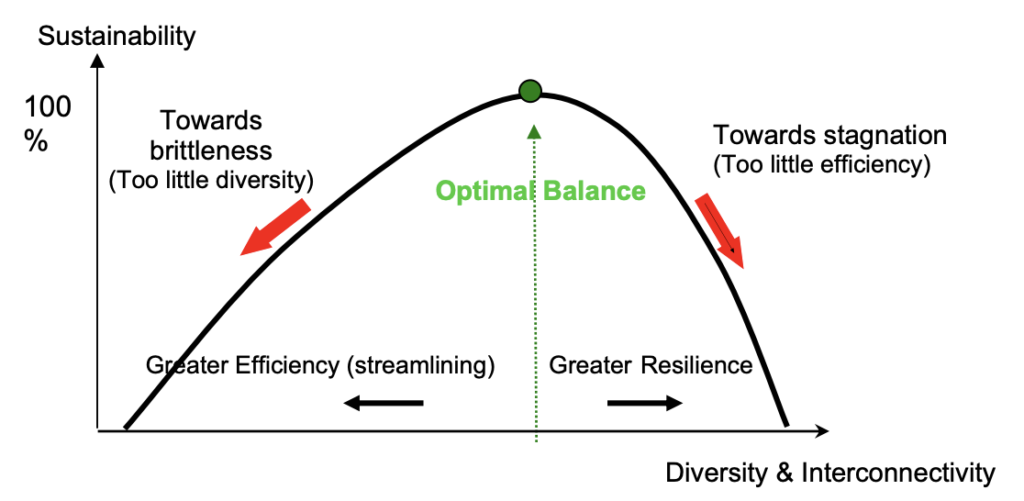
Pace Layers & Racism: Systems Demonstrated
2020 has been an intense case study in systems thinking. I teach systems design at the undergraduate level, and originally had the idea to write a series of articles called “Systems Demonstrated” about COVID-19 and why we were seeing such sharp global spread and supply chain shortages. However, I think Black Lives Matters offers a more urgent case for introspection.
I’ve been thinking hard about how to make a meaningful contribution to the current conversation on racism. I don’t live the experience of people of colour, and am concerned about BLM becoming a passing fad amongst white people: Make a few tweets, get a selfie at a protest, boost your status then resume life as usual.
To be clear on my stance – BLACK LIVES MATTER and so do the ongoing global protests. I want to see these protests catalyze deeper change, and systems analysis can help us to do this methodically. One of my favourite systems frameworks is the concept of pace layers by Stewart Brand. The idea is that society is structured along multiple layers that operate at different paces of change.

Culture is long-lasting and difficult to change, like a freight ship turning in the ocean. Fashion is fast, dynamic and short-lived – it is meant to emerge in a flash and disappear just as quickly. The magic idea is that you can take action in one layer to influence change in the layer below or above.
Herein lies my concern – protests take place in the fashion layer. They stir up a lot of attention and bring important issues into the public dialogue, then quickly fade into memory. Yet racism is a deeply embedded cultural issue. We need these protests to drive change layer-by-layer deeper into society, from the way we run our organizations, to the rules we set in policy, down to the very fabric of our culture.
We’ve seen some business leaders stepping up, and this may be a good start, (though many are skeptical). Corporations are in control of their own governance and can make policy changes quickly. Today, corporate executive teams and boards are disproportionately filled by white men like me. It’s easy to hide behind the belief that I overcame my own form of adversity to get to a position of influence, but the reality is I do have privilege. I may have modest small town origins, but my ability to climb the ladder was always going to be easier than for a visible minority in my exact same position. It’s easier for me to come across as a “good guy”, and for leaders to see a little piece of themselves in me. This is the “unconscious bias” we’ve been hearing about so much in the media.
Unconscious bias is one of the things we need to combat, not just with awareness that it exists, but by diversifying leadership teams that bring different and unique biases to the table.
So what is unconscious bias? One of many cognitive biases, it is a subtle mental shortcut that our brain takes to make decisions. This is usually quite useful and helps us navigate an overwhelming amount of complex information each day, but it can also steer us away from objective decision making if we don’t catch it. One of the experiences that clearly demonstrated the idea of unconscious bias to me was when my wife Min changed her last name. Previously, Min would apply to jobs as “Min Soo Kim”. She often felt overlooked and stereotyped as a candidate (i.e. maybe she should be applying for an analyst role). A former manager, when talking about promotions, told Min there was nothing wrong with the quality of her work, but that “something just wasn’t there” with her – the rest of the team was white. When Min changed her name to FitzGerald, opportunity abounded by contrast. People would look at her with surprise when they met her, having expected her to be white or half-white. It opened doors when she was fundraising in Silicon Valley. It gave her a platform to be seen as a leader. This shouldn’t be the case, but it was. Yet the novelty wears off. It was easier to get intros, but still challenging to get results. Min had a tougher time raising money for her startup as an Asian woman, despite being minted in the world’s most prestigious startup accelerator YCombinator. She would see white men with nothing but an idea and a PowerPoint deck raise a cool $500,000 in five meetings, but be told to come back in six months once she had more traction.
There is an invisible system, formed of millions of unconscious decisions, that silently directs our actions and the amount of opportunity that people can access. Min and I still both live a life of opportunity. Neither of us fear the police, or have been taught to keep our hands in our pockets while shopping on the assumption that we’re probably going to steal something. How did we get here? How did society decide that some groups were trustworthy and others weren’t? What even is race?
Race is a “folk taxonomy” that has emerged over centuries of declaring people part of in-groups and out-groups. Who belongs to which race has actually been pretty fluid over time. For example, different groups have been considered “white” over the years. At one point Eastern Europeans were considered a separate group than white people. The Caucasus – the namesake of Caucasian people – is located in West Asia. We’ve moved people in and out of different racial classifications over time, and assigned positive and negative associations to these groups. Asian Americans, for example, eventually came to be seen as industrious, from earlier associations of “exotic” that still persist today. Black people, through systematic oppression, colonialism and slavery were painted as inferior. While race and racial-associations are social constructs, the outcomes of believing in race are very real. Millions have died, been tortured and denied opportunity for centuries in the name of a social construct of race. Yet, pretending that race doesn’t exist also doesn’t help.
There is a concept in ecosystem studies of efficiency and resiliency. We often refer to this concept in climate change, for example when comparing the difference between a new-growth human-planted, mono-culture forest and a natural, biodiverse old-growth forest. Our society has a tendency to favour efficient solutions, but these efficient systems can also be quite fragile. A mono-culture forest is easier to plant after clear-cutting a forest, but can easily be wiped out by disease.

I think a lot of the ways we’ve tried to address racism in the past fall in the camp of “efficient solutions.” We’d like to all be able to say “I don’t see colour” and declare racism over. We’d like to meet a minimum diversity threshold in our organizations, and declare that we’ve done our part. But these are efficient, fragile solutions that don’t get at the heart of change.
Resilient systems live in constant tension. An equal system shouldn’t feel comfortable. At least not for a very long time. It should involve difficult, awkward discussions. It should not be harmonious – there should be conflict that arises from keeping people accountable to their commitments. It should include a broad diversity of experiences, perspectives and biases that may not align. Resilient systems are often slower – decisions are more challenging to make. This is a trade-off we can bear. Regardless of how you feel about history, let’s acknowledge that the system is broken today and can be improved.
We need to embed principles of inclusion, diversity and equality in every layer of society and it’s not enough to stop at policy. It’s easier to point fingers at authority and demand that they change the rules of the game, but overcoming racism is going to require an even deeper cultural shift. We can start by looking in the mirror and seeing our actions in the bigger system. We can catch ourselves in the act when we have knee-jerk perceptions about minority groups. We can have the courage to start conversations about race that feel uncomfortable, actively seek diverse perspectives, and be willing to be challenged and to challenge others. We can vote for leaders who demonstrate their values, not just their sound bites. We can be willing to sacrifice romantic ideas about the past for a more vibrant vision of our future.
I hope to be kept accountable of my own actions, and to create an environment where anyone feels safe to do so. I remain committed to evolve my point of view, and doing what I can to influence system change layer by layer.
I’ve categorized a number of actions that have been recommended to me by layer. Anyone can act on these simple steps today.
Fashion Layer: Participate in the online dialogue. Take part in local protests and movements. Read the news. Stay informed of multiple perspectives.
Commerce Layer: Ask hard questions of your leadership team. Push for a more thorough hiring and retention policy. Hold or participate in discussions about diversity and inclusion. Actively seek diverse feedback – it’s not enough to expect it to flow freely.
Infrastructure Layer: Education, Science and the Justice system can all be seen as societal infrastructure. Keep yourself educated. Read books like “How to be an Anti-Racist“. Donate to organizations like Bail Funds or the Equal Justice Initiative.
Governance Layer. VOTE. Write or call your local government representative with policy changes you’d like to see them support. Put your beliefs to action by voting for parties and candidates that prioritize equality and inclusion.
Culture Layer: Listen, reflect and be willing to change your point of view. Listen to the perspectives of people who are victims of racial injustice and brutality. Catch yourself judging someone with an old stereotype. Lead by example and challenge others to do the same.
